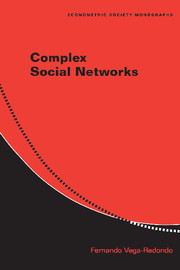Book contents
- Frontmatter
- Contents
- Preface
- 1 Introduction
- 2 Complex Networks: Basic Theory
- 3 Epidemic Diffusion
- 4 Neighborhood Effects in Diffusion and Play
- 5 Searching in Social Networks
- 6 Search, Diffusion, and Play in Coevolving Networks
- Afterword
- A Generating Functions
- B The Ising Model
- C Mean-Field Theory
- Bibliography
- Index
- Econometric Society Monographs
4 - Neighborhood Effects in Diffusion and Play
Published online by Cambridge University Press: 05 January 2013
- Frontmatter
- Contents
- Preface
- 1 Introduction
- 2 Complex Networks: Basic Theory
- 3 Epidemic Diffusion
- 4 Neighborhood Effects in Diffusion and Play
- 5 Searching in Social Networks
- 6 Search, Diffusion, and Play in Coevolving Networks
- Afterword
- A Generating Functions
- B The Ising Model
- C Mean-Field Theory
- Bibliography
- Index
- Econometric Society Monographs
Summary
In social contexts, the diffusion of information and/or behavior often exhibits features that do not match well those of the epidemic models discussed in Chapter 3. This concerns, specifically, the transmission mechanism contemplated by those models, which was assumed to be independent of the local (neighborhood) conditions faced by the agents concerned.
In the epidemic formulation of diffusion, the transmission of infection (or information) to a healthy (or uniformed) agent is tailored to her total exposure, i.e. the absolute number of infected neighbors. But in the spread of many social phenomena – mainly if there is a factor of persuasion or coordination involved – relative considerations tend to be important in understanding whether some new behavior or belief is adopted. Generically, we shall speak of these relative considerations operating on the diffusion process as neighborhood effects. They are the object of the present chapter, where we study their implications in a number of different setups.
NEIGHBORHOOD-DEPENDENT DIFFUSION IN RANDOM NETWORKS
In this starting section, we revisit the epidemic models considered in Chapter 3, now under neighborhood effects. First, in Subsection 4.1.1, the focus is on a SIR-like context where diffusion is irreversible and thus one may naturally conceive of diffusion as occurring through a wave of a certain reach. Next, in Subsection 4.1.2, we turn to a setup where diffusion spreads in a way akin to SIS-epidemics, with adoption/infection being only temporary. In this latter case, the concern is the extent of long-run prevalence.
- Type
- Chapter
- Information
- Complex Social Networks , pp. 109 - 154Publisher: Cambridge University PressPrint publication year: 2007



